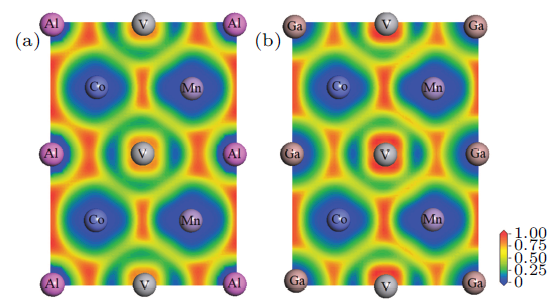|
|
Density functional theory investigation on lattice dynamics, elastic properties and origin of vanished magnetism in Heusler compounds CoMnVZ (Z= Al, Ga)
Hot!
Guijiang Li(李贵江), Enke Liu(刘恩克), Guodong Liu(刘国栋), Wenhong Wang(王文洪), and Guangheng Wu(吴光恒)
Chin. Phys. B, 2021, 30 (8):
083103.
DOI: 10.1088/1674-1056/ac0a6a
The lattice dynamics, elastic properties and the origin of vanished magnetism in equiatomic quaternary Heusler compounds CoMnVZ (Z=Al, Ga) are investigated by first principle calculations in this work. Due to the similar constituent atoms in CoMnVAl and CoMnVGa compounds, they are both stable in LiMgPdSn-type structure with comparable lattice size, phonon dispersions and electronic structures. Comparatively, we find that CoMnVAl is more structurally stable than CoMnVGa. Meanwhile, the increased covalent bonding component in CoMnVAl enhances its mechanical strength and Vickers hardness, which leads to better comprehensive mechanical properties than those of CoMnVGa. Practically and importantly, structural and chemical compatibilities at the interface make non-magnetic semiconductor CoMnVAl and magnetic topological semimetals Co2MnAl/Ga more suitable to be grown in heterostructures. Owing to atomic preferential occupation in CoMnVAl/Ga, the localized atoms Mn occupy C (0.5, 0.5, 0.5) Wyckoff site rather than B (0.25, 0.25, 0.25) and D (0.75, 0.75, 0.75) Wyckoff sites in LiMgPdSn-type structure, which results in symmetric band filling and consequently drives them to be non-magnetic. Correspondingly, by tuning localized atoms Mn to occupy B (0.25, 0.25, 0.25) or/and D (0.75, 0.75, 0.75) Wyckoff sites in off-stoichiometric Co-Mn-V-Al/Ga compounds and keeping the total valence electrons as 24, newly compensated ferrimagnetic compounds are theoretically achieved. We hope that our work will provide more choices for spintronic applications.

|